Journal of Advances in Physical Chemistry
Vol.
08
No.
03
(
2019
), Article ID:
31759
,
6
pages
10.12677/JAPC.2019.83007
Effect of Temperature and SOC on Storage Performance of Lithium Iron Phosphate Batteries
Songke Mao, Dexiang Tian, Ting Xiao, Hongyan Wenren
Zhejiang GBS Energy Co., Ltd., Yuyao Zhejiang

Received: Jul. 26th, 2019; accepted: Aug. 12th, 2019; published: Aug. 19th, 2019

ABSTRACT
The storage performance of plastic case 100 Ah lithium iron battery was tested, and the effects of temperature, SOC (state of charge) and other factors on the storage performance of lithium iron phosphate power battery were investigated. The results show that different temperatures and SOC have different effects on the storage of batteries with the same storage time. The capacity attenuation of batteries is greatest at 55℃, while 0% and 100% SOC are not the best charging conditions for the performance of batteries. Combined with various factors, the optimum storage conditions of lithium iron phosphate batteries were investigated.
Keywords:Temperature, State of Charge, Storage Performance
温度、SOC对铁锂电池存储性能的影响
毛松科,田德祥,肖婷,闻人红雁
浙江佳贝思绿色能源有限公司,浙江 余姚

收稿日期:2019年7月26日;录用日期:2019年8月12日;发布日期:2019年8月19日

摘 要
对塑壳100 Ah铁锂电池进行存储性能测试,考察了温度、SOC (荷电状态)等因素对磷酸铁锂动力电池存储性能的影响。结果表明,相同的存储时间,不同的温度和不同SOC对电池的存储影响各不相同,55℃对电池的容量衰减影响最大,而0%和100% SOC均不是最有利电池性能发挥的最佳荷电状态,综合各种因素,考察了磷酸铁锂电池的最佳存储条件。
关键词 :温度,荷电状态,储存性能

Copyright © 2019 by author(s) and Hans Publishers Inc.
This work is licensed under the Creative Commons Attribution International License (CC BY).
http://creativecommons.org/licenses/by/4.0/


1. 引言
近年来,随着能源危机的到来,以及面临可持续发展的挑战,燃油汽车将逐渐被新能源的纯电动汽车和混合动力汽车所替代。电动汽车主要以锂离子电池为动力源,其可再生、可重复利用引起众多企业和研发工作者的高度关注。而为其提供动力的锂离子电池具有绿色环保、可循环再用的特点,另外还具有寿命长、容量高、体积小、重量轻等优点 [1] [2] [3] 。而磷酸铁锂电池除了具有锂离子电池通用的优点外,还具有较高安全性能和使用寿命等优势。所以铁锂电池在储能和动力方面应用渐广。然而,不同的存储条件会对磷酸铁锂电池的性能产生不同的影响。因此设置储存条件,使其在储存前后仍旧拥有较好的荷电保持能力具有非常重要的意义 [4] [5] [6] [7] 。
孙庆等 [8] 通过研究不同的温度对磷酸铁锂电池的充放电性能的影响,探求磷酸铁锂电池最佳的储存和使用环境,实验结果表明,当温度保持在0℃~55℃时,电池荷电保持能力最佳。
本文为了更加详细的探究铁锂电池最佳的储存和运输条件,采用若干只方形容量为100 Ah的磷酸铁锂电池为测试对象,将样品电池分别储存在不同温度下,监控电池在存储前后的容量、电压、内阻的变化,以及存储前后容量的衰减率和恢复率,给出常温下SOC 60%时为最佳储存条件。
2. 实验
以方形126*65*242 mm塑壳磷酸铁锂电池为研究对象,额定容量100 Ah,正极采用磷酸铁锂,负极材料采用人造石墨,正极材料与SP (导电剂)、KS-6 (导电剂)、LA132 (粘结剂)和水按比例混合搅拌成正极浆料,涂布在铝箔上,负极材料与SP (导电剂)、LA132 (粘合剂)和水,按比例混合搅拌成负极浆料涂布在铜箔上,两种材料后续通过分切,辊压,叠片,封装,注液,化成等工序形成电池。
分别取各9个电池,在−40℃、25℃和55℃环境下,分别以100% SOC、60% SOC和0% SOC存储一个月,每三天测试其开路电压和交流内阻,存储结束后测试其容量衰减率和容量恢复率。高低温箱采用HAG-2型,交流内阻仪,电性能测试设备T-100型。
3. 结果与讨论
3.1. 存储30天过程中电池的开路电压、交流内阻的变化
图1~图3给出了实验电池存储30天过程中的开路电压变化,从图中可见不同温度、不同SOC状态下存储过程中开路电压有一定的变化,一致性最好的是在60% SOC状态下,变化最大的是0% SOC状态下。这与LiFePO4/石墨体系电池在不同SOC状态下的极化有很大关系,一般该系列电池在0% SOC状态下极化最大,60% SOC极化最小 [9] 。
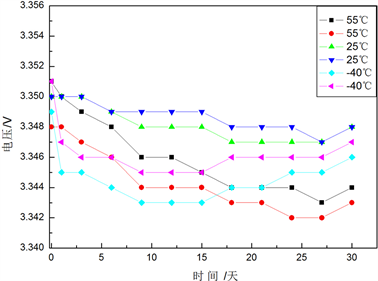
Figure 1. 100% SOC different temperature open circuit voltage change diagram
图1. 100% SOC不同温度开路电压变化图
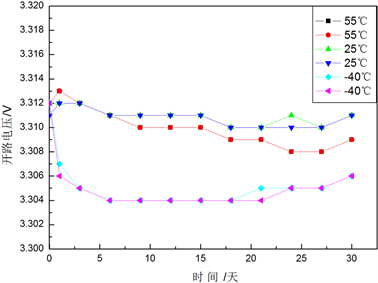
Figure 2. 60% SOC open temperature voltage change diagram
图2. 60% SOC不同温度开路电压变化图
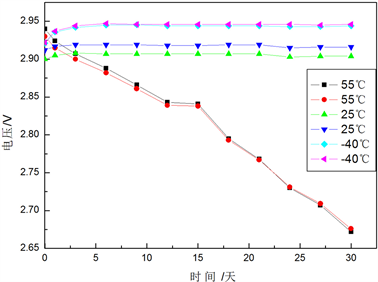
Figure 3. 0% SOC different temperature open circuit voltage change diagram
图3. 0% SOC不同温度开路电压变化图

Figure 4. 100% SOC different temperature AC internal resistance change diagram
图4. 100% SOC不同温度交流内阻变化图

Figure 5. 60% SOC different temperature AC internal resistance change diagram
图5. 60% SOC不同温度交流内阻变化图

Figure 6. 0% SOC different temperature AC internal resistance change diagram
图6. 0% SOC不同温度交流内阻变化图
实验电池存储30天的交流内阻变化如图4~图6所示,从图中可以看出,不同SOC、不同温度下存储后的电池内阻变化并不明显。−40℃低温下,在搁置7天时内阻达到最大值达到了50 mΩ左右,之后下降恢复正常值,这可能是由于在极低温度下,电解液由游离态变为凝状态,之后再阻抗缓慢降低。
3.2. 存储30天后电池容量的保持能力和恢复能力
图7,图8是电池存储30天后容量的保存率和恢复能力,从图中可以看出,随着温度的上升,电池容量保存率和恢复能力降低,低SOC更利于电池容量的保存,这是由于随着温度的上升,离子活性增加,电池内部产生副反应,导致电池容量衰减。
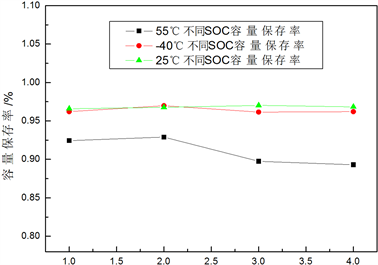
Figure 7. Different SOC capacity retention rates at different temperatures
图7. 不同温度不同SOC容量保存率
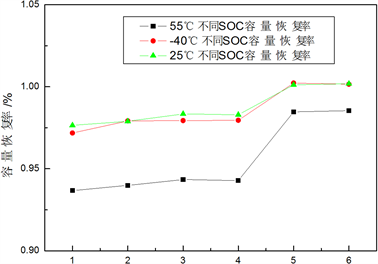
Figure 8. Different SOC capacity recovery capabilities at different temperatures
图8. 不同温度不同SOC容量恢复能力
3.3. 存储30天后电池循环寿命
图9给出了不同温度不同SOC电池存储30天的循环寿命,从图中可见,25℃ 60% SOC情况下电池的循环寿命最好,相同温度下,随着SOC的增加,电池的容量衰减大,相同SOC下,55℃高温容量衰减最大,其次是−40℃。

Figure 9. Different SOC cycle life at different temperatures
图9. 不同温度不同SOC循环寿命
4. 结论
① 温度越高,电池存储性能越差,55℃对电池的容量衰减影响最大。
② 0%和100% SOC均不是最有利电池性能发挥的最佳荷电状态,综合各种因素,常温下60% SOC为最佳存储条件。
文章引用
毛松科,田德祥,肖 婷,闻人红雁. 温度、SOC对铁锂电池存储性能的影响
Effect of Temperature and SOC on Storage Performance of Lithium Iron Phosphate Batteries[J]. 物理化学进展, 2019, 08(03): 59-64. https://doi.org/10.12677/JAPC.2019.83007
参考文献
- 1. 蒋志君. 锂离子电池正极材料磷酸铁锂: 进展与挑战[J]. 功能材料, 2010, 41(3): 365-368.
- 2. 王鸿麟, 田金玉, 王英杰. 锂离子电池[J]. 电信技术, 1997(11): 23-24.
- 3. 王成俊, 韩晓丽, 郭爱红, 等. 锂离子二次电池电解质的研究进展[J]. 天津化工, 2004(2): 1-3.
- 4. Bruno, S. and Jurgen, G. (2010) Lithium Batteries: Status, Prospects and Future. Journal of Power Sources, 195, 2419-2430. https://doi.org/10.1016/j.jpowsour.2009.11.048
- 5. Arai, J., Yamaki, T., Yamauch, S., et al. (2005) Development of a High Power Lithium Secondary Battery for Hybrid Electric Vehicles. Journal of Power Sources, 146, 788-792. https://doi.org/10.1016/j.jpowsour.2005.03.087
- 6. Sarah, J., Gondelach, G. and Faaij, A.P.C. (2012) Performance of Batteries for Electric Vehicles on Short and Longer Term. Journal of Power Sources, 212, 111-129. https://doi.org/10.1016/j.jpowsour.2012.03.085
- 7. Wang, L., Huang, Y., Jiang, R., et al. (2007) Preparation and Characteri-zation of Nanosized LiFePO4 by Low Heating Solid-State Coordination Method and Microwave Heating. Electrochimica Acta, 52, 6778-6783. https://doi.org/10.1016/j.electacta.2007.04.104
- 8. 孙庆, 杨秀金, 代云飞. 温度对磷酸铁锂电池性能的影响[J]. 电动自行车, 2011(9): 22-27.
- 9. Goodenough, J.B. (2007) Cathode Materials: A Personal Perspective. Journal of Power Sources, 174, 996-1000. https://doi.org/10.1016/j.jpowsour.2007.06.217